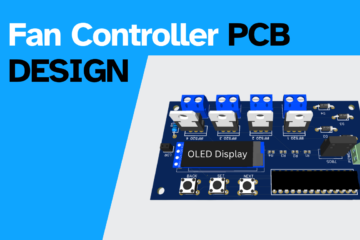This Smart Sensor PCB is designed to integrate multiple sensors with an ESP32-DevKit-V1, allowing real-time environmental monitoring and data collection. It includes connections for:
- DHT22 (Temperature & Humidity Sensor)
- I2C CO₂ Sensor (Air Quality Monitoring)
- Ultrasonic Sensor (Distance Measurement)
- ESP32-CAM (Wireless Image/Video Capture)
The PCB provides stable power distribution, sensor interfaces, and efficient communication channels using I2C, UART, and GPIO.

Features of Smart Sensor PCB Design:
Multiple Sensor Support – Easily interface DHT22, CO₂ sensor, ultrasonic sensor, and ESP32-CAM.
Wi-Fi & Bluetooth Connectivity – Use ESP32 for cloud communication and remote access.
Stable Power Management – DC input with regulated power for all components.
Compact & Modular Design – Optimized for IoT applications, with headers for future expansion.
Components used in Smart Sensor PCB Design:
(A) Microcontroller Unit
- ESP32-DevKit-V1
- Acts as the main controller for all sensors.
- Communicates wirelessly via Wi-Fi or Bluetooth.
- Controls the ESP32-CAM for capturing images.
- Manages sensor data and uploads it to a cloud or local server.
(B) Power Supply & Connectors
- DC-005-2.5A-2.0 (DC Jack)
- Power input connector to supply 5V or 12V (converted to 3.3V for ESP32).
- Ensures stable voltage distribution to sensors.
- HDR-TH_15P-P2.54-V-F (Pin Header – 15 Pin, 2.54mm pitch)
- Provides easy connections for external sensors and modules.
- Allows additional I/O expansion if needed.
- S4B-PH-K-S-(LF)(SN) (4-Pin Connector)
- A 4-pin JST connector used for connecting the I2C CO₂ sensor or other modules.
(C) Resistors & Other Components
- 12kΩ Resistor
- Used as a pull-up resistor for the I2C communication lines or sensor input stabilization.
- 470Ω Resistor
- Used for current limiting in LEDs or signal conditioning.
- GT-TCB73B-H048-L1 (Tactile Push Button)
- Can be used as a reset button for ESP32 or as a manual trigger for sensor readings.
Working of the Smart Sensor PCB:
(A) Power Distribution
- The DC-005 connector receives external power (typically 5V or 12V).
- The ESP32 operates at 3.3V, so a voltage regulator is used internally.
- Sensors like the DHT22, I2C CO₂ sensor, and Ultrasonic Sensor receive their required operating voltage from the PCB.
(B) Sensor Connections
- DHT22 Sensor (Temperature & Humidity)
- Connected to a GPIO pin of the ESP32 for single-wire communication.
- I2C CO₂ Sensor (Air Quality Monitoring)
- Connected via I2C pins (SDA, SCL) using the S4B-PH-K-S connector.
- Ultrasonic Sensor (Distance Measurement)
- Connected to two GPIO pins (Trigger & Echo) for measuring distance.
- ESP32-CAM Module
- Communicates with the ESP32-DevKit-V1 via UART for image and video streaming.
(C) Data Processing & Communication
- The ESP32 collects sensor data and sends it via Wi-Fi or Bluetooth to a cloud platform (e.g., Blynk, Thingspeak, Firebase).
- It can also store the data locally on an SD card (if added to the design).
- The ESP32-CAM captures images and streams them to a smartphone or web dashboard.



Applications of Smart Sensor PCB Project:
Environmental Monitoring – Monitor temperature, humidity, CO₂ levels, and distance remotely.
Smart Home & IoT – Automate indoor climate control based on sensor readings.
Security & Surveillance – ESP32-CAM provides remote monitoring capabilities.
Industrial Use – Measure air quality in factories or warehouses
Conclusion:
This ESP32-Based Multi-Sensor PCB is a compact and efficient IoT solution for monitoring environmental conditions with real-time data logging and wireless control.
Would you like assistance with the PCB schematic, firmware programming, or mobile app integration?
Need This Project?
If you need this Project with or without Modifications or Customization then you can contact us through WhatsApp. We can deliver you this Project in the Following Ways.
Project Code:
we can provide you Project Code along with Zoom Assistant, through Zoom meeting for Setup of this Project or any other Arduino Project of your need.
Fully Functional Project with Hardware/Components Shipment:
if you can not make this project yourself then you can use this option. We will assemble the Project and will ship it to your Doorstep with Safe Packaging.
Learn More about the services we offer.



